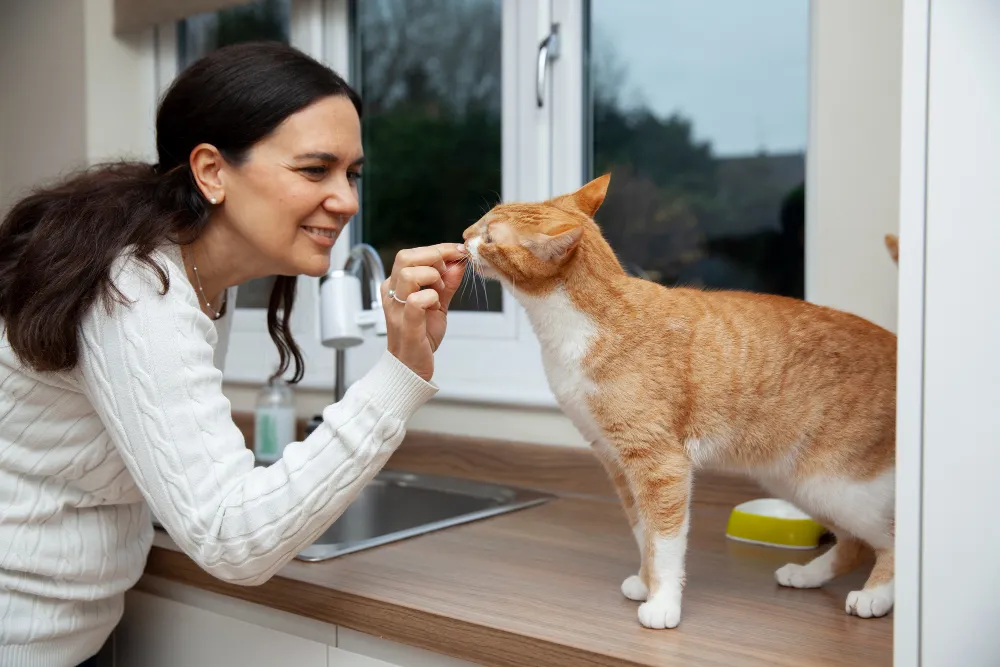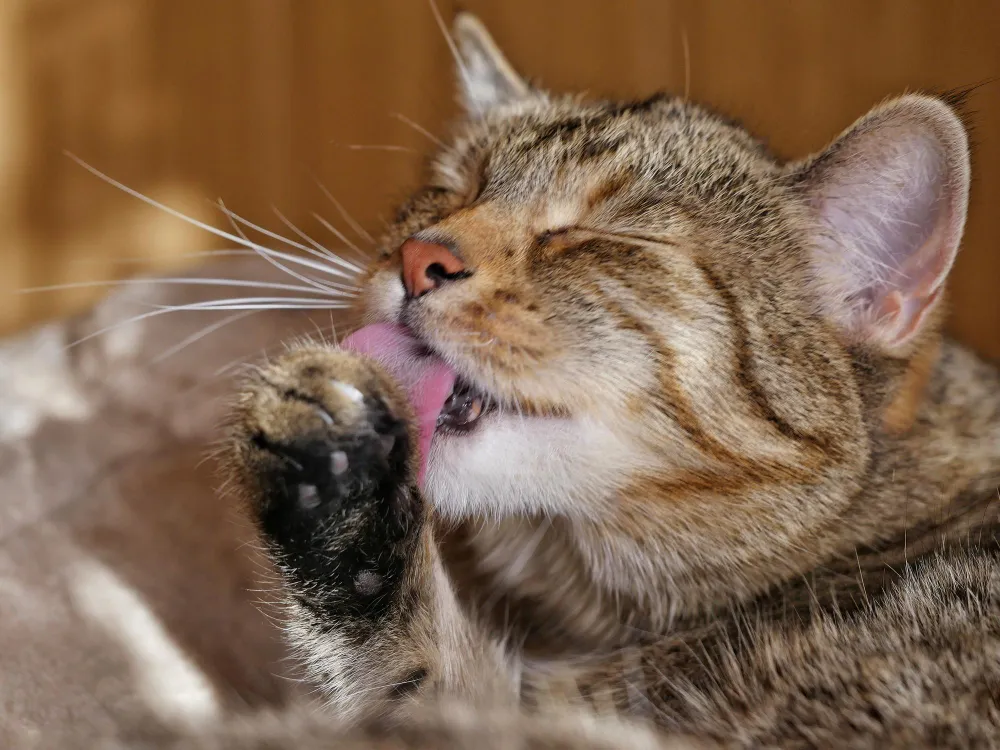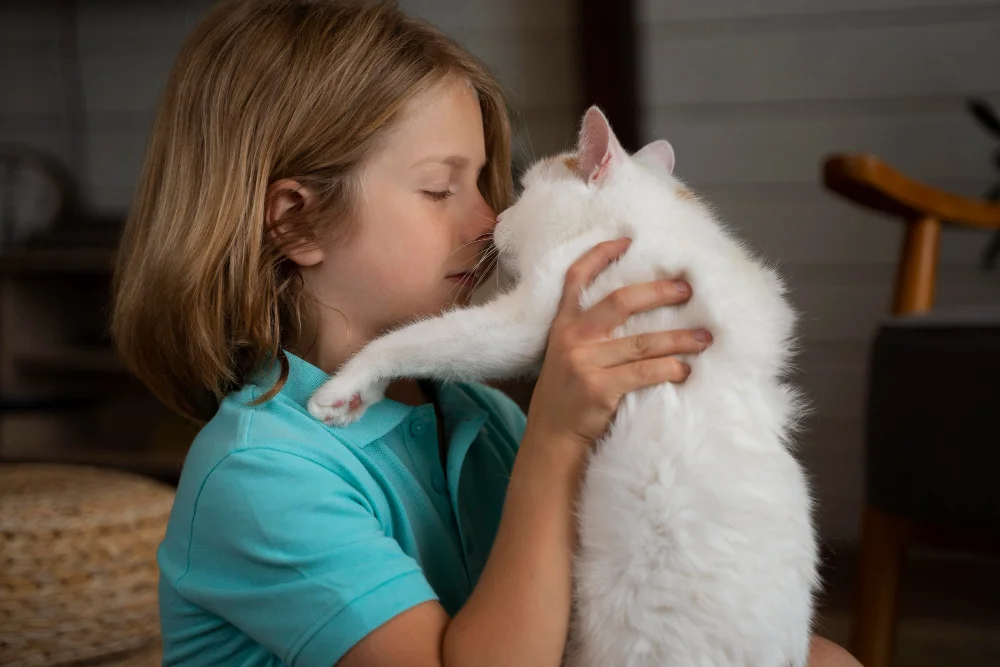You’re curled up on the couch, enjoying a peaceful moment with your cat. They start licking your hand gently—a sweet and affectionate gesture. But just when you think it’s a bonding moment, chomp! They bite you! Confused? You’re not alone.
Why does my cat lick me then bite me?
This puzzling behavior leaves many cat owners scratching their heads. One moment your feline friend is all love and licks, the next, you’re dealing with a sudden nip. Understanding cat behavior can help you make sense of this mixed signal.
In this blog, we’ll break down five surprising but common reasons behind this quirky feline habit, diving into the cat licking and biting meaning and what your kitty is trying to tell you.
Reason 1: Affection Overload (Love Bites)
Sometimes, your cat isn’t being aggressive at all. What feels like a bite might actually be a cat love bite—a form of gentle communication. Cats groom each other with both licks and nibbles, and this mix of licking and biting is a way they show affection.
When cats bond, they often engage in mutual grooming, and soft bites are part of that ritual. So if you’re wondering why cats bite gently, it could be their way of saying, “I love you, but that’s enough.”
This behavior is especially common in cats that are very comfortable with their owners. It reflects affectionate cat behavior that mimics how they interact with their feline family.

Reason 2: Overstimulation During Petting
Even the most affectionate kitty has its limits. What starts as a relaxing petting session can quickly turn into petting aggression in cats.
Cats are highly sensitive animals. Continuous petting, especially in certain areas like the belly or base of the tail, can overstimulate their nerves. The result? A sudden bite after some licks.
You can usually spot signs of cat overstimulation before the bite happens. Look for:
- Tail flicking
- Ears turned sideways or back
- Twitching skin
- Tense body posture
If you’re asking why cats bite while being petted, it’s likely they’ve hit their tolerance limit.
Reason 3: Grooming Behavior Mimicry
Your cat may be treating you like one of their own. In feline communities, grooming isn’t just about cleanliness—it’s about social bonding.
Licking followed by a small nip is part of how cats interact during grooming. This cat grooming habit is deeply ingrained and instinctive. So if your cat is licking and nibbling, they could be mimicking the mutual grooming they would normally do with other cats.
This behavior indicates trust and comfort. It’s a good sign that your cat feels close to you—just don’t take the nibble personally!
Reason 4: Playfulness or Boredom
Cats, especially kittens and high-energy breeds, often show affection through rough play. If your cat is licking and then biting you, it may just be playtime.
Why cats bite during play has to do with how they learn to interact and hunt. Even indoor cats retain these instincts. They might start by licking to engage you and then bite as part of their playful attack.
If your cat gets too rough, try redirecting them to interactive play with cats using toys like feather wands or treat puzzles. This helps reduce cat play aggression and satisfies their hunting urges without hurting you.
Reason 5: Communication or Warning
Sometimes, the bite is not playful or affectionate—it’s a message.
Your cat may lick to get your attention, but bite to tell you they’ve had enough, or that something is wrong. This is a form of feline communication and should be taken seriously.
Pay attention to the frequency and context of the behavior. If your cat seems anxious, is avoiding touch, or bites more aggressively, it could be a sign of cat anxiety behavior or even discomfort.
A sudden bite after licking might simply be a warning: “That’s enough.” Learn to read these cat warning signs and respect their space.


What You Should Do (Tips for Managing the Behavior)
If your cat’s licking-then-biting behavior is frequent, here are some tips to reduce and manage it:
- Understand their signals: Recognize when your cat is becoming overstimulated or agitated.
- Avoid petting sensitive zones: Stick to areas like the head, cheeks, and under the chin.
- Use toys for interaction: Redirect playful aggression to appropriate toys, not your hands.
- Provide enrichment: Keep your cat mentally and physically active with playtime, window views, and puzzle feeders.
These small adjustments can go a long way in helping you stop cat biting behavior and improve your bond through cat-friendly playtime.
When to Worry: Medical or Behavioral Issues
Most of the time, licking followed by biting is normal. But there are exceptions.
If your cat starts doing it aggressively, frequently, or out of the blue, it could be a red flag. This might indicate underlying cat behavior problems, pain, or illness.
Some medical causes of aggression in cats include:
- Dental issues
- Skin irritation
- Arthritis or joint pain
- Neurological disorders
If the behavior seems sudden or severe, it’s time to see a vet for cat biting. A professional can help determine if it’s medical or behavioral—and offer a plan.
FAQs
Is it normal for cats to lick and then bite? Yes, it’s very common and often normal feline behavior, especially if it happens during grooming or play.
Do all cats do this? Not all, but many do—especially cats that are affectionate or easily overstimulated.
Can I train my cat not to bite after licking? Yes. With patience, you can redirect their behavior using toys, reward calm behavior, and avoid overstimulation.
Are there breeds more prone to this? Some breeds, like Siamese and Bengals, are more active and expressive and may be more prone to playful cat bites.
This section helps answer your licking then biting cat FAQ and reinforces cat behavior explained.

Conclusion
So, why does my cat lick me then bite me? It’s usually not an act of aggression. It’s a mix of love, communication, and instinct. Whether your cat is showing affection, becoming overstimulated, mimicking grooming, playing, or giving a warning, understanding the context is key.
By learning feline communication signs and respecting your cat’s boundaries, you’ll deepen your bond and avoid the unexpected nips.
Remember: Every cat is unique. Pay attention to their body language, respond with care, and when in doubt, consult your vet.

